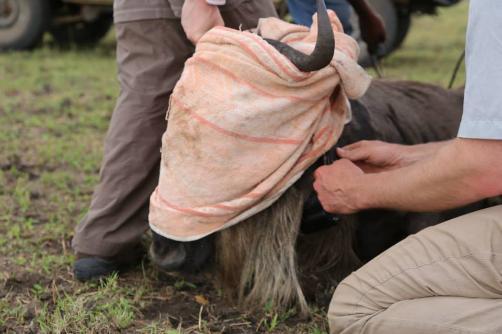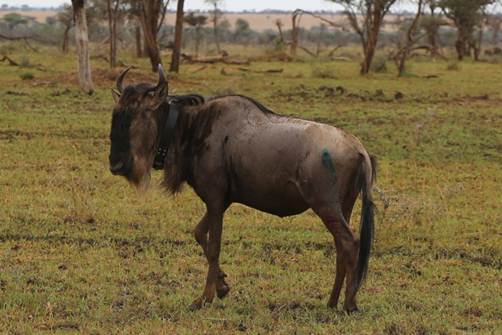How do wildebeest move across the landscape?
Published: 13 May 2015
Our researchers are using state-of-the-art techniques to understand wildebeest movement from the scale of the migration to their immediate reactions to a predator in their midst.
 Dr Grant Hopcraft attaches a radio tracking collar to a wildebeest
Dr Grant Hopcraft attaches a radio tracking collar to a wildebeest
Our researchers are using state-of-the-art techniques to understand wildebeest movement from the scale of the migration to their immediate reactions to a predator in their midst.
Dr Grant Hopcraft is working with a team of people from the University of Glasgow and the Tanzania Wildlife Research Institute to radio-collar wildebeest as they move across the Serengeti on their annual migrations. When animals have their collars attached, researchers also collect additional samples (temperature, blood, tail hair) to check the health of the animal and use for additional work. The tail hair in particular is forming the basis of a project examining whether isotope signatures can tell us more about where animals go and what they eat.
In addition to tracing large scale movements over the landscape, the team is also looking at small scale movements - how do wildebeest respond to predators in their midst? Using drones, the team is watching how herds react to the presence of predators. The goal is to put all the information together and be able to monitor herd health, movements and predation pressure from a distance - a very large distance, using satellite monitoring.
The work of this team represents long-standing and valuable relationships between our researchers and the Tanzanian institutions who hold responsibility for one of the world's most dynamic ecosystems. Many TAWIRI and TANAPA staff hold University of Glasgow degrees and are now supervising new generations of Tanzanian researchers-in-training. By working together, this research program has been able to provide valuable data to park managers and park users. One of the more public outputs of this research is the development of Serengeti Tracker, which allows anyone to see where the collared wildebeest are at any time, and to see what other wildlife have been spotted in the park!
 A newly collared wildebeest ready to rejoin the migration
A newly collared wildebeest ready to rejoin the migration
First published: 13 May 2015

